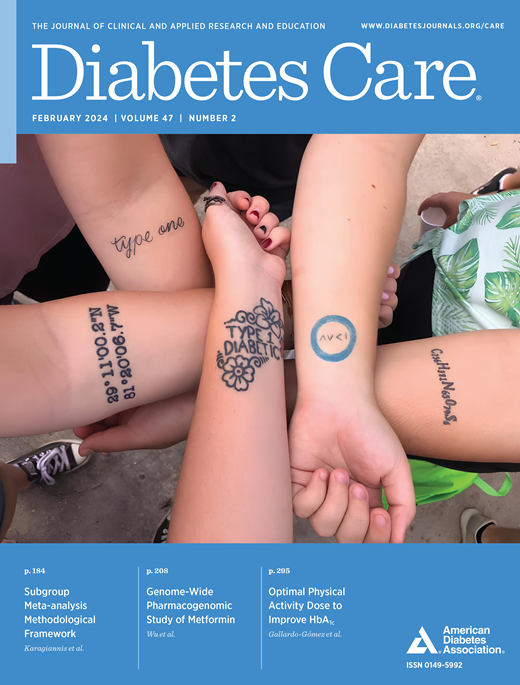糖尿病血液透析患者连续血糖监测的准确性
IF 14.8
1区 医学
Q1 ENDOCRINOLOGY & METABOLISM
引用次数: 0
摘要
目的 在普通人群中,与传统的自我血糖监测相比,连续血糖监测(CGM)可提供方便、侵入性更小的血糖测量,并可减少低血糖/高血糖,延长目标血糖范围的时间。然而,在血液透析患者中,CGM 相对于血糖的准确性尚未得到很好的证实。研究设计和方法 在 2020 年 10 月至 2021 年 5 月住院的 31 名维持性血液透析糖尿病患者中,我们使用 Dexcom G6 CGM 与血糖进行了协议血糖测量,后者在每餐前和夜间进行测量,并在血液透析期间每 30 分钟测量一次。我们使用 Bland-Altman 图、一致性百分比、绝对相对差异 (ARD) 平均值和中位数以及共识误差网格检查了 CGM 与血糖的相关性以及 CGM 与血糖的一致性。结果 CGM 与血糖平均水平的皮尔逊和斯皮尔曼相关性分别为 0.84 和 0.79;Bland-Altman 显示 CGM 与血糖的平均差异为 +15 mg/dL。在总体、血液透析和非血液透析期间,使用 %20/20 标准计算的一致率分别为 48.7%、47.2% 和 50.2%。所有时间段的平均 ARD (MARD) 均低于 20%;总体期间的中位 ARD 为 19.4%,非血液透析期间(18.2%)略低于血液透析期间(22.0%)。共识误差网格显示,几乎所有 CGM 值都在临床可接受的 A 区(无伤害)和 B 区(不太可能造成重大伤害)。结论 在血液透析糖尿病患者中,虽然 MARD 值高于传统的最佳分析性能阈值,但误差网格显示几乎所有 CGM 值都在临床可接受范围内。需要进一步研究 CGM 是否能改善血液透析患者的治疗效果。本文章由计算机程序翻译,如有差异,请以英文原文为准。
Accuracy of Continuous Glucose Monitoring in Hemodialysis Patients With Diabetes
OBJECTIVE In the general population, continuous glucose monitoring (CGM) provides convenient and less-invasive glucose measurements than conventional self-monitored blood glucose and results in reduced hypo-/hyperglycemia and increased time-in-target glucose range. However, accuracy of CGM versus blood glucose is not well established in hemodialysis patients. RESEARCH DESIGN AND METHODS Among 31 maintenance hemodialysis patients with diabetes hospitalized from October 2020–May 2021, we conducted protocolized glucose measurements using Dexcom G6 CGM versus blood glucose, with the latter measured before each meal and at night, plus every 30-min during hemodialysis. We examined CGM-blood glucose correlations and agreement between CGM versus blood glucose using Bland-Altman plots, percentage of agreement, mean and median absolute relative differences (ARDs), and consensus error grids. RESULTS Pearson and Spearman correlations for averaged CGM versus blood glucose levels were 0.84 and 0.79, respectively; Bland-Altman showed the mean difference between CGM and blood glucose was ∼+15 mg/dL. Agreement rates using %20/20 criteria were 48.7%, 47.2%, and 50.2% during the overall, hemodialysis, and nonhemodialysis periods, respectively. Mean ARD (MARD) was ∼20% across all time periods; median ARD was 19.4% during the overall period and was slightly lower during nonhemodialysis (18.2%) versus hemodialysis periods (22.0%). Consensus error grids showed nearly all CGM values were in clinically acceptable zones A (no harm) and B (unlikely to cause significant harm). CONCLUSIONS In hemodialysis patients with diabetes, although MARD values were higher than traditional optimal analytic performance thresholds, error grids showed nearly all CGM values were in clinically acceptable zones. Further studies are needed to determine whether CGM improves outcomes in hemodialysis patients.
求助全文
通过发布文献求助,成功后即可免费获取论文全文。
去求助
来源期刊

Diabetes Care
医学-内分泌学与代谢
CiteScore
27.80
自引率
4.90%
发文量
449
审稿时长
1 months
期刊介绍:
The journal's overarching mission can be captured by the simple word "Care," reflecting its commitment to enhancing patient well-being. Diabetes Care aims to support better patient care by addressing the comprehensive needs of healthcare professionals dedicated to managing diabetes.
Diabetes Care serves as a valuable resource for healthcare practitioners, aiming to advance knowledge, foster research, and improve diabetes management. The journal publishes original research across various categories, including Clinical Care, Education, Nutrition, Psychosocial Research, Epidemiology, Health Services Research, Emerging Treatments and Technologies, Pathophysiology, Complications, and Cardiovascular and Metabolic Risk. Additionally, Diabetes Care features ADA statements, consensus reports, review articles, letters to the editor, and health/medical news, appealing to a diverse audience of physicians, researchers, psychologists, educators, and other healthcare professionals.
 求助内容:
求助内容: 应助结果提醒方式:
应助结果提醒方式:


